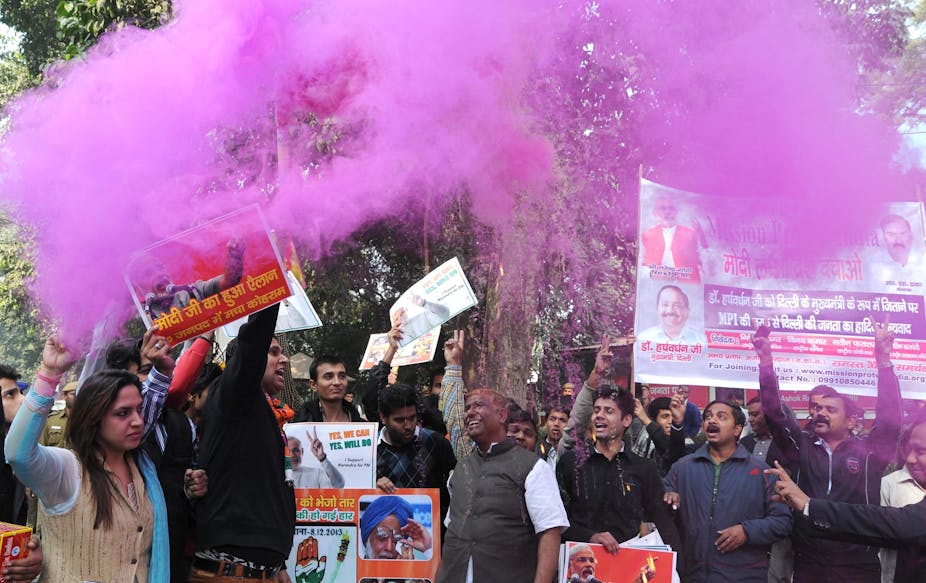Recent state election results in India point to the Congress Party losing power in national elections this year.
The Indian National Congress has led India as the biggest party in a national coalition government since 2004. But in the four most recent state election results, announced last December, Congress was comprehensively defeated in the northern states of Delhi, Madhya Pradesh, Rajasthan and Chhattisgarh.
Recent corruption scandals have seriously harmed the government’s reputation. The emergence of a popular new prime ministerial contender in the Bharatiya Janata Party’s Narendra Modi also played a role in the state elections.
But the deeper cause of the Congress’ setbacks is its failure to produce a new and lasting strategy for building political legitimacy in post-economic reform India. Before the era of economic reform dating back to the 1980s, political legitimacy rested on two ideologies with mass appeal.
Anti-colonial nationalism succeeded until the 1960s in maintaining a consensus on the government’s program of autonomous, urban-focused industrialisation. This was initiated under India’s first prime minister, Jawaharlal Nehru. Populism then underpinned the policies of socialist redistribution attempted by his daughter, Indira Gandhi, in the late 1960s and 1970s.
As public sector debt accumulated and growth rates stagnated, India launched a series of economic reforms. The aim was to improve growth rates by strengthening indigenous private business.
This focus on private business, markets and growth intensified in the 1990s. The Indian government gradually opened up the economy while abandoning the legitimising rhetoric of socialism and policies of redistribution.
Yet while the last two decades delivered higher growth rates, levels of inequality also increased. Successive governments struggled to find a new ideology with mass appeal. They failed to build a broad political coalition in support of the economic reform agenda.
The Bharatiya Janata Party (BJP) held power at the national level from 1998 to 2004. In this time, the BJP attempted to build mass support for private-business-oriented growth on the back of religious nationalism. The Hindu nationalist movement has sought to marry social conservatism with the economic strategy introduced by the Congress.
In doing so, the BJP has privileged Hindu religion and culture as the basis for nationhood. This has had the effect of excluding and marginalising India’s many religious minorities. Rural-urban divides and class and caste cleavages have also been papered over.
The limits of this strategy became evident when the BJP was trounced in national elections in 2004. The defeated government infamously ran a campaign based on the slogan “India shining”. Rising malnutrition rates and a spate of farmer suicides clearly indicated otherwise.
The Congress Party’s “inclusive growth” strategy was another attempt to legitimise India’s post-1990 focus on private indigenous business, markets and growth.
Two major outcomes of this approach have been large-scale social welfare schemes. The National Rural Employment Guarantee Act (NREGA) guarantees a minimum of 100 days of wage employment, mainly on public works, in rural areas. The Food Security Act provides subsidised wheat, rice and grains to about two-thirds of the population.
Though it is too soon to make a judgement on the success or failure of these programs, both have had their critics. The implementation of the NREGA has been uneven across Indian states. The Food Security Act has been criticised for adding to India’s growing fiscal deficit and for its reliance on notoriously corrupt delivery systems for the subsidised food.
The inclusive growth strategy has also not tackled the key sources of growing inequality. These include a decline in public investment in agriculture and a lack of job creation in manufacturing. Now the economic climate has darkened and growth rates have begun to falter.
The Congress government has also not met the governance expectations of the growing urban middle classes. What then are the alternatives offered by the Congress’s opponents?

Narendra Modi is the chief minister of Gujarat, one of India’s most rapidly industrialising states. Here, the BJP has successfully melded an indigenous private sector-led industrialisation strategy and active state intervention with Hindu nationalist ideology. This has produced high growth rates and electoral majorities despite high levels of inequality.
Modi remains, however, a deeply divisive figure. He is tainted by his alleged role in precipitating violence between Hindus and Muslims in Gujarat.
Furthermore, the strength of the business-state alliance in Gujarat is the result of a unique history of collaboration and weak opposition. A replication of the Modi model at a national level is unlikely to succeed.
The vacuum of political legitimacy helps explain the rise of the Aam Aadmi (common man) Party (AAP). The AAP unexpectedly won 28 out of 70 seats in the Delhi elections.
The new party grew out of a split in the middle-class-driven movement against corruption led by the veteran political activist, Anna Hazare. The movement’s brand of populist anti-politics is driven by a deep sense of alienation from the ruling elites. In this, it resembles movements that have emerged in other countries with rising urban middle classes, such as Turkey and Brazil.
In venturing into the political arena, the AAP, which is led by Arvind Kejriwal, a former public servant, has promised to go beyond this populist anti-politics. By emphasising its anti-corruption stance and willingness to run campaigns against entrenched business interests, the new party may challenge the dominance of the business-state alliance in post-reform India. For the time being, however, its lack of a tangible political program means the AAP remains a symptom rather than a solution to the crisis in Indian politics.
All this suggests two things. India may well elect a new national government next year, with the BJP at the helm and new parties in opposition. Despite that, the crisis of legitimacy that has marked the last two decades of Indian politics is likely to continue.

